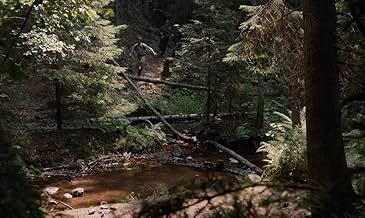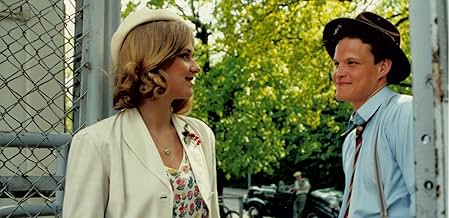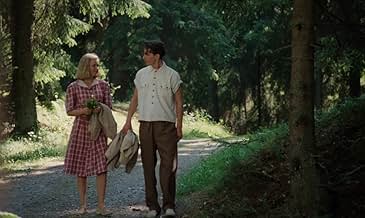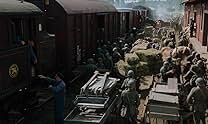1939
- 1989
- 3h 13min
CALIFICACIÓN DE IMDb
6.1/10
1.1 k
TU CALIFICACIÓN
Agrega una trama en tu idiomaWorld War II through the eyes of a Stockholm waitress.World War II through the eyes of a Stockholm waitress.World War II through the eyes of a Stockholm waitress.
- Dirección
- Guionistas
- Elenco
Opiniones destacadas
Just take the time to really watch this movie. Great acting and styling. 5.6 rating is ridiculous.
...should be around 7-8.
1939 is now available on Netflix worldwide having an audience 100 times more than in 1989 when was filmed. Quality is outstanding subsequent remastering.
The movie is maybe a bit too long, but not boring, great acting, interesting subject, reflecting actually Swedish people life during WWII, that being a neutral country was far better than life of French, Dutch, or Norwegian people. The only reason I don't give more than 8 stars is that finishes too suddenly letting you open to think about how might continue. What I liked especially is that everything happens during action is natural and not as in a soap movie.
The title is a misnomer ,for the story spans the whole WW2 till the allies' victory.
"1939" is essentially a chronicle ,in a country that maintained their policy of neutrality ,but breached it in favor of the German , later the allies ;these troubled time are seen through the eyes of a young blond girl (Helene Egehund ) and the best thing in this sometimes sprawling slow-moving work is the depiction of a female friendship ,a subject much less broached than the male one) ; the marvelous Helena Bergström almost steals the show from the principal ,and although their relationship is pure and platonic, it sets a pattern for today's women who live with a child (when Peter is stricken by croup ,both girls show that the baby has two moms: when Berit speaks to the thespian , in the background , the director does not use the usual code).
Churchill once said that the country "played both sides for profit ";it is certainly true for Bengt's family whose business with the Germans was thriving but who was searching new markets when the Nazi 's star faded ;the sames goes for the owner of the chic restaurant where "Arbeit macht frei ". But it also happened in occupied countries where there were collaborators too.
Too bad the other side ,represented by the heroine's cousin ,a socialist who 's sent to a labor camp ,is underwritten .
Bengt , Annika 's husband certainly embraced the Nazi's obnoxious ideology ,when he lets his friends check if his wife is really an Aryan .Annika will always be an intruder in her family-in-law (the scene of the restaurant where she works and where her future father-in-law snubs her is revealing); when she leaves him and Berit does not let the brute in , they take a rebel stand at a time feminism did not exist ;as I wrote , the Berit/Annika relationship is the raison d'être of the film .
"1939" is essentially a chronicle ,in a country that maintained their policy of neutrality ,but breached it in favor of the German , later the allies ;these troubled time are seen through the eyes of a young blond girl (Helene Egehund ) and the best thing in this sometimes sprawling slow-moving work is the depiction of a female friendship ,a subject much less broached than the male one) ; the marvelous Helena Bergström almost steals the show from the principal ,and although their relationship is pure and platonic, it sets a pattern for today's women who live with a child (when Peter is stricken by croup ,both girls show that the baby has two moms: when Berit speaks to the thespian , in the background , the director does not use the usual code).
Churchill once said that the country "played both sides for profit ";it is certainly true for Bengt's family whose business with the Germans was thriving but who was searching new markets when the Nazi 's star faded ;the sames goes for the owner of the chic restaurant where "Arbeit macht frei ". But it also happened in occupied countries where there were collaborators too.
Too bad the other side ,represented by the heroine's cousin ,a socialist who 's sent to a labor camp ,is underwritten .
Bengt , Annika 's husband certainly embraced the Nazi's obnoxious ideology ,when he lets his friends check if his wife is really an Aryan .Annika will always be an intruder in her family-in-law (the scene of the restaurant where she works and where her future father-in-law snubs her is revealing); when she leaves him and Berit does not let the brute in , they take a rebel stand at a time feminism did not exist ;as I wrote , the Berit/Annika relationship is the raison d'être of the film .
This is a slow burner for sure. But it rewards a bit of patience so stick with it. The performances and casting are excellent and the characters are all three dimensional. In the course of three hours you get to know them and understand the changing world through their eyes. All of which makes one scene particularly shocking. It's always a good sign when a film stays with you after the credits roll and this one has. Maybe the slow pace matches the mood of lockdown but I thoroughly enjoyed it.
1939 was a major project in the Swedish film industry. The Swedish people were invited to send in short descriptions of their own experiences during the war. The events depicted in the film are based on these stories. The main character, Annika, is based on a woman in real life, who travelled from Värmland to Stockholm to start a new life.
The film does create plausible images of what went on in Sweden during the war. The film also illustrates a time of transition, both for the world (from the old, safe environment to a new, unsecure one with prospects and dangers) and for the young people, who were forced to grow up quickly during this violent period of time. Everyone had to decide how to relate to the new world and what to do about their personal roots and beliefs. This is why I find the film so interesting.
I agree that 1939 can be considered slow at times, but I also happen to think that it is a tempo which suits the tale that is told. In my book, the key line is during one of the slower moments, when Annika's father says to Annika something along the lines of: "I am afraid of what's coming. Don't forget the old ways, Annika. Don't forget the way we used to live." Looking out over the meadows of his home, he realises that he is being left behind by the development, and that Annika and her peers are left at the helm. For me it is a thoroughly moving moment in the film. With the fast pace that we are living today, we would all do well to heed his plea.
This film didn't get the credit I think it merited, and at least for us Swedes 1939 should be considered an important film.
The film does create plausible images of what went on in Sweden during the war. The film also illustrates a time of transition, both for the world (from the old, safe environment to a new, unsecure one with prospects and dangers) and for the young people, who were forced to grow up quickly during this violent period of time. Everyone had to decide how to relate to the new world and what to do about their personal roots and beliefs. This is why I find the film so interesting.
I agree that 1939 can be considered slow at times, but I also happen to think that it is a tempo which suits the tale that is told. In my book, the key line is during one of the slower moments, when Annika's father says to Annika something along the lines of: "I am afraid of what's coming. Don't forget the old ways, Annika. Don't forget the way we used to live." Looking out over the meadows of his home, he realises that he is being left behind by the development, and that Annika and her peers are left at the helm. For me it is a thoroughly moving moment in the film. With the fast pace that we are living today, we would all do well to heed his plea.
This film didn't get the credit I think it merited, and at least for us Swedes 1939 should be considered an important film.
¿Sabías que…?
- TriviaFeature film debut of both Helene Egelund and Per Morberg.
- ErroresWhen Annika travels home to her parents for Christmas, you see an aerial view of the train going through the woods. In the lower right corner of the screen you can see a part of the landing railing of the helicopter from which the scene was filmed.
- Créditos curiososThe closing credits include an unusual job description: "Helena Olofsson-Carmback (as Helena Carmback) .... Shouting and whispering"
- ConexionesEdited into Max Manus (2008)
Selecciones populares
Inicia sesión para calificar y agrega a la lista de videos para obtener recomendaciones personalizadas
- How long is 1939?Con tecnología de Alexa
Detalles
Taquilla
- Presupuesto
- SEK 30,000,000 (estimado)
- Tiempo de ejecución3 horas 13 minutos
- Mezcla de sonido
- Relación de aspecto
- 1.66 : 1
Contribuir a esta página
Sugiere una edición o agrega el contenido que falta

Principales brechas de datos
By what name was 1939 (1989) officially released in Canada in English?
Responda
















